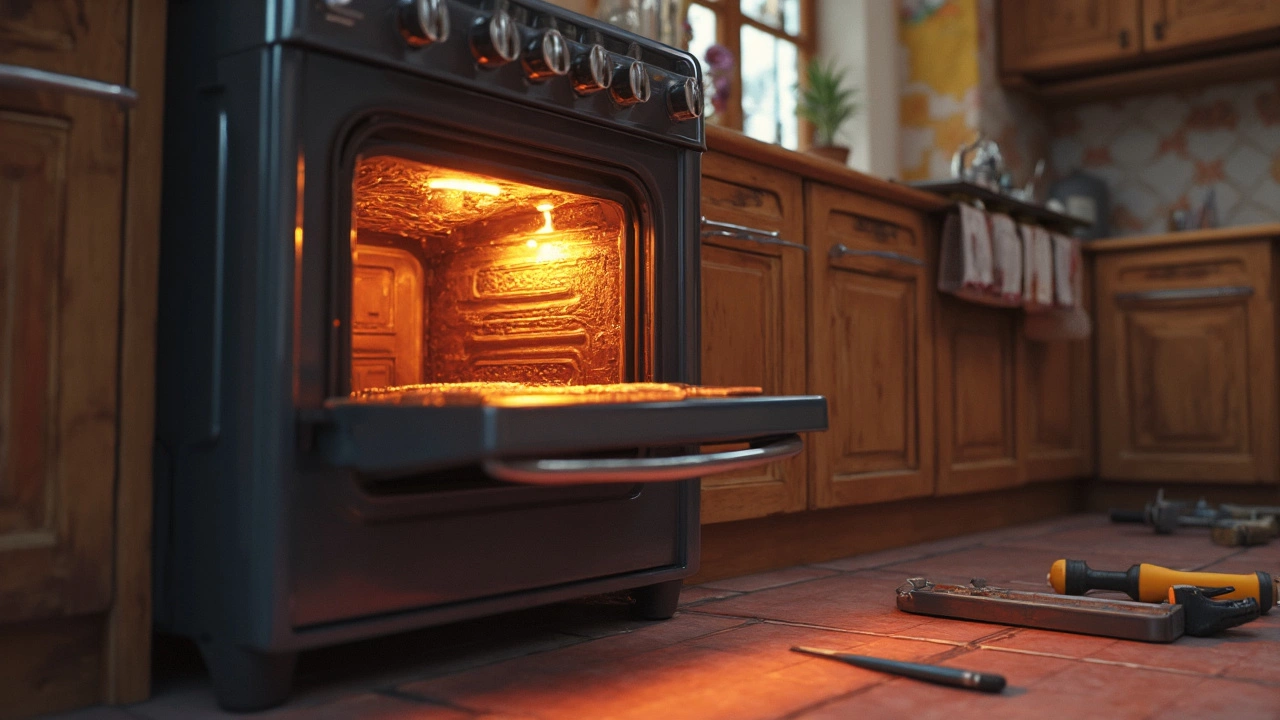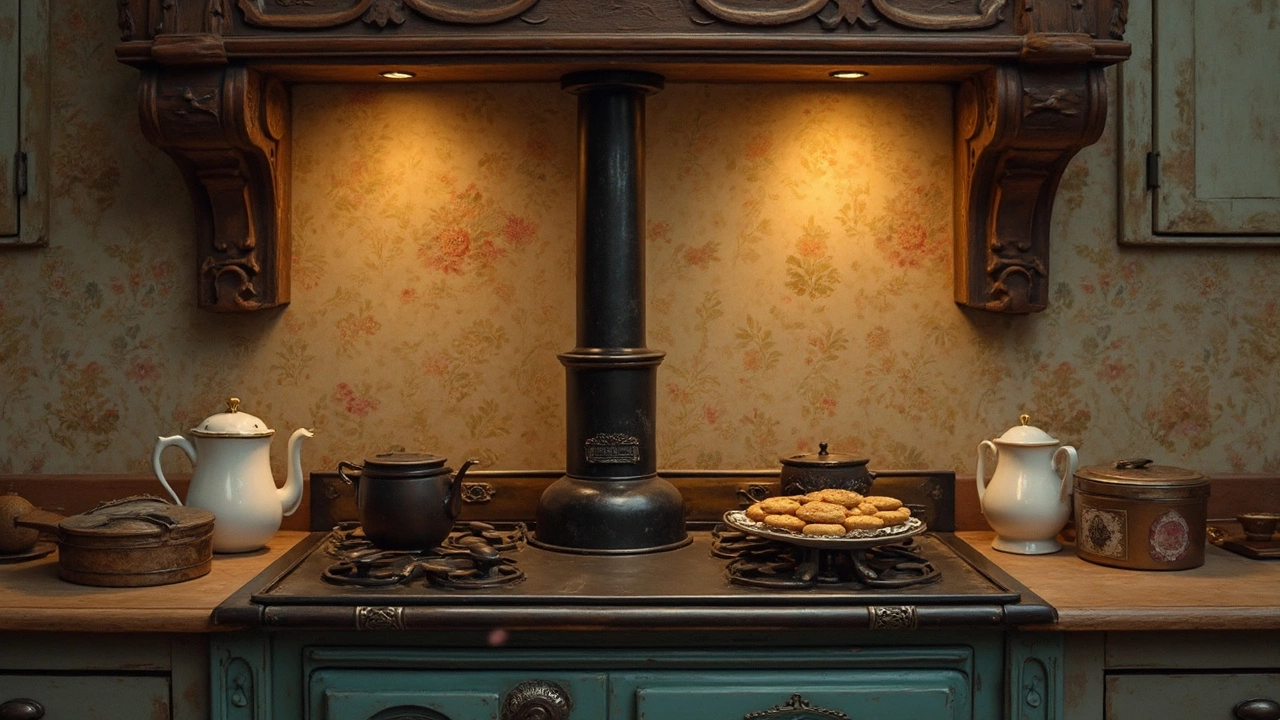
- 12 Apr 2025
- Gideon Thornton
- 0
So, you’re all set to bake your favorite cookies, but the oven's just not playing ball. It’s like it suddenly realized it's an introvert that doesn't want to party. Before panic sets in or you pick up the phone to call an expert, chill a bit. There might be some simple DIY tricks you can try first.
One major reason ovens go cold is faulty heating elements. Electric ovens have a couple of these guys – they’re like the rock stars that actually create all the heat while the rest of the oven just supports the show. When they burn out, no baking party for you. Gas ovens, on the other hand, might be having fun with a dodgeball-sized gas flow issue or a broken igniter.
But hold up. Before fiddling with these parts, always unplug your oven or switch off the gas supply. Trust me, you don’t want any unintended sparks flying. Next, give the inside a good once-over. Are the elements visible and intact in electric ovens? If they're looking like a snapped rubber band, you’ve found your problem.
- Common Causes of a Cold Oven
- Basic Troubleshooting Tips
- Electric Ovens vs. Gas Ovens
- When to Call a Professional
- Maintenance Tips to Prevent Future Issues
Common Causes of a Cold Oven
If your oven's treating you with the cold shoulder, let's figure out why. A few usual suspects might be lurking around, messing with your culinary plans. Knowing what they are can help you fix things up without sweating too much.
Faulty Heating Elements are often the first to blame in an electric oven not heating. These are the parts responsible for creating heat, so when they’re busted, it’s game over for your baking sessions. Peek inside and see if the element looks burnt out or broken. If you spot any damage, swapping it out with a new one could be the answer.
In gas ovens, the issue might be with the igniter. If the igniter is weak or broken, it won't light the gas properly, leaving your oven cold. You might notice it taking a long time to ignite; that’s a sign it's on its way out.
Thermostat Malfunction is another troublemaker. This little sensor controls the oven temperature, so if it’s not working right, your oven may not heat up. Check if your oven is heating less than it should—even if it’s just a tiny bit below the required temperature, the thermostat might be the one to blame.
Have you ever heard of a blown thermal fuse? It's like a safety guard in your electric oven, shutting things down to prevent overheating. If it’s blown, your oven will stop heating altogether. You can only confirm this with a multimeter—if there’s no continuity, it’s time for a replacement.
Lastly, let’s not forget about power supply issues. For electric ovens, this could mean checking the circuit breaker or the outlet to ensure everything is in good shape. A simple power glitch might be the real culprit keeping your oven cool.
Here's a quick look at some data to give you an idea of how often these problems pop up:
| Problem | Occurrence (%) |
|---|---|
| Heating Element Failure | 35% |
| Igniter Issues | 25% |
| Thermostat Malfunction | 20% |
| Blown Thermal Fuse | 15% |
| Power Supply Issues | 5% |
Armed with this info, you’re probably ready to tackle that cold oven head-on. Remember, safety first, especially when dealing with electrical or gas components!»
Basic Troubleshooting Tips
Alright, so you're ready to roll up your sleeves and get that oven back to its A-game. Let’s break it down with some basic troubleshooting you can handle at home. No advanced degree needed, just a bit of patience and maybe a flashlight.
First things first, always make sure your oven is unplugged from the power source or that the gas is turned off before you start poking around. Safety's no joke here.
Here’s a quick checklist you can tackle:
- Check the Power Source: Sounds simple, but you might be surprised how often this is the culprit. Ensure your oven is plugged in and that the circuit breaker hasn’t tripped. Sometimes the solution is as easy as a quick flip of a switch.
- Inspect the Heating Element: If you’ve got an electric oven, take a look at the heating elements. Are they glowing red hot when switched on? If not, they might need replacing. For gas ovens, check if the igniter is sparking.
- Thermostat Settings: This little dial can be pretty temperamental. Make sure it’s set to the desired temperature and hasn't been bumped.
- Look for Error Codes: Some fancy models flash codes when something’s off. Grab your manual, decode those cryptic numbers, and you might just solve the issue.
- Inspect the Door Seal: If the seal is damaged, heat escapes like a teapot with the lid off. New weatherstripping could do magic.
Remember, a bit of DIY can save money and time. But if you're facing persistent issues, don't hesitate to call in an expert, especially for complex fixes or issues that involve gas lines.
Taking these small steps can ensure your oven gets back to firing up meals smoothly while avoiding unnecessary headaches.

Electric Ovens vs. Gas Ovens
When your oven decides it's not going to heat up, it’s crucial to know whether you’re dealing with an electric oven or a gas oven, as the issues and fixes can be quite different. Let’s break it down so you know what you’re up against.
Electric Ovens are all about the heating elements. They're pretty much the stars in your oven's concert. You’ve usually got two: one at the top for broiling and one at the bottom for baking. If these elements stop working, the oven might just sit there looking pretty but doing nothing.
- First, check if the elements are glowing red. If not, they might need replacing.
- Use a multimeter to test for continuity – no beep, no heat.
- Inspect for any visible damage or breaks in the elements.
If the elements are fine, the issue could stem from the oven’s thermostat, the selector switch, or even the control board. This is where things start to get a bit techy, so unless you’re comfortable with circuitry, you might want to call a pro.
Gas Ovens add another layer of complexity. Here, the igniter is usually the main culprit if your pizza’s staying raw. An igniter that's not drawing enough current won’t open the safety valve to release gas.
- You’ll hear clicking but no flame? Check the igniter.
- Again, no continuity with a multimeter means it’s a dud.
Make sure your gas supply is on and unobstructed. Sometimes a quick visual inspection inside can show you blockages that might be interrupting the flow.
Here’s a fun little stat: around 65% of home ovens in the U.S. are electric. So, if you’re in the majority, those heating elements should be your first suspect!
Having a good understanding of what type of oven repair you’re faced with can save a lot of time and headaches. Knowing whether it's an electric or gas issue gives you a head start on narrowing down the problem and figuring out the next move.
When to Call a Professional
Sometimes your oven acts up in ways that scream, "Hey, call in the pros!" Not every issue is DIY-friendly, and knowing when to hang up your tool belt can save you time and maybe even prevent bigger repair bills. Here are a few signs it's time to bring in an expert.
If you've ruled out the obvious things like a blown fuse or tripped circuit breaker, and your oven isn't heating still, it might be an electrical problem. Unless you're an electrician moonlighting as a chef, you'll want someone who can safely check the wires and connections. Don't risk a shock or making things worse.
- You hear weird buzzing or see persistent sparking. Sparks aren't part of any cooking recipe I know. This could indicate deeper electrical issues.
- There’s a persistent gas smell when using a gas oven. That’s a big red flag. Gas leaks are dangerous and should only be handled by professionals.
- Electronic control panel starts malfunctioning. It's not your league unless you've got the tech skills of someone who codes software in their sleep.
Besides safety, licensed repair folks often carry parts with them. If your oven needs a new heating component, they might have it on the spot, saving you multiple trips to the store.
| Issue | Professional Needed? |
|---|---|
| Heating elements not glowing | Possibly |
| Gas leaks | Definitely |
| Electrical or wiring issues | Yes |
Always remember, if you’re outside of your comfort zone or find yourself over-Googling for answers, it’s worth calling someone who does this for a living. Plus, they might spot something you missed, saving you future headache and cash. Knowing when to call a repair person can often be what saves your next culinary masterpiece from being eternally raw.

Maintenance Tips to Prevent Future Issues
A little bit of love and care goes a long way with ovens. You want them to last and perform when it matters, right? So, how about we dive into some super practical oven repair preventative maintenance tips that will keep your oven working like a charm.
First up, regularly clean the oven’s interior. Grease and food spills can mess with heating elements and gas parts. Wipe things down with mild detergents every couple of months—or more if your famous lasagna notoriously overflows.
Check those door gaskets too. A tight seal keeps heat in, making sure your oven isn’t sneakily wasting energy. Simply run your hand around the door's perimeter to feel for drafts. If it's breezy, you might want to replace those gaskets.
For electric ovens, inspect the heating elements. Once every six months should be good. Look for any signs of wear or breakage. If they’re glowing unevenly, it might be time for a quick swap-out.
Gas ovens need their own dose of attention. Keep the igniter and burners clean to prevent clogs. Use a soapy brush or even just a toothpick to clear out tiny bits of gunk blocking gas flow.
Finally, if you have a fancy oven with digital controls, those touchpads need some gentle dusting. Use a dry microfiber cloth and don’t let moisture sneak into the circuitry.
| Maintenance Task | Recommended Frequency |
|---|---|
| Clean Interior | Every 2-3 months |
| Check Door Seals | Every 6 months |
| Inspect Heating Elements | Twice a year |
| Clean Gas Burners | Twice a year |
| Dust Digital Controls | Once a month |
Keep in mind that good basic maintenance helps avoid many oven emergencies and keeps those appliance repair bills at bay. Plus, staying on top of care means your oven can keep pushing out perfect roasts and cookies for many more family dinners to come!




